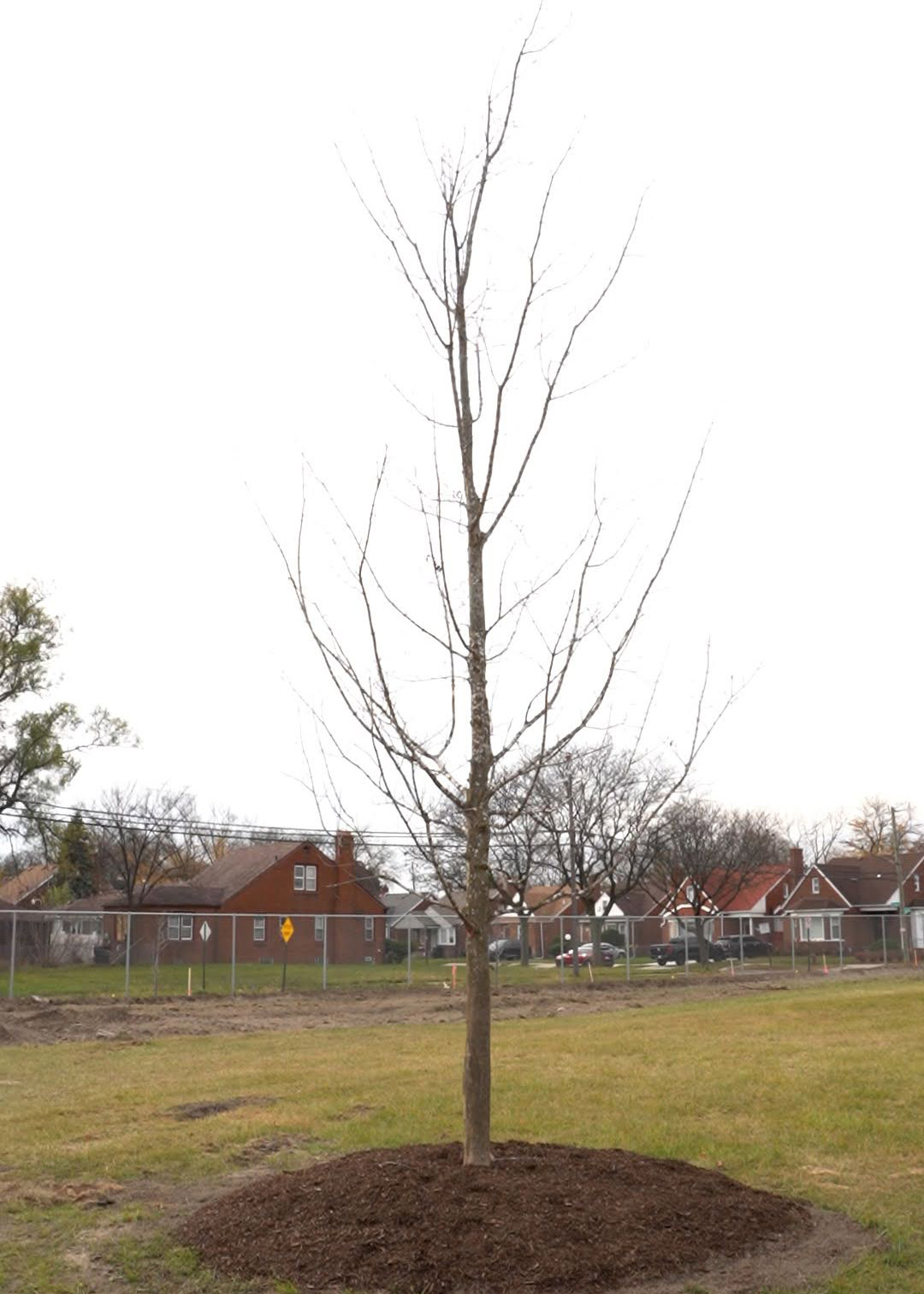Trees are an efficient, inexpensive source of carbon capture and therefore a part of the solution to mitigate the effects of climate change
How well do you know the trees of Gmeiner Park? Did you know that trees, along with plants and healthy turf, provide cleaner air, lower ground temperatures and a means for the community to recharge and connect.
Gmeiner Park is a 10-acre green oasis for more than 5,000 Detroit residents. It provides them with access to a unique neighborhood greenspace for recreation, play, and opportunities to gather.
In the fall of 2022, Project EverGreen, the Gilbert Family Foundation and Community Foundation for Southeast Michigan, along with local landscape and tree care professionals, renovated Gmeiner Park adding a new six-foot wide, half-mile walking path to draw people into the park to play and exercise, new tables and benches, and planting 16 mature trees in and around the perimeter of the park.
Greener, healthier, cooler environments turn the tide for communities across the United States.
THEY CREATE: OUTDOOR ENJOYMENT HEALTHEIR LIFESTYLES ECONOMIC GROWTH COMMUNITY DEVELOPMENT ENVIRONMENTAL BENEFITS
Project EverGreen, in partnership with the Michigan Economic Development Corporation
The Trees of Gmeiner Park
Sugar Maple
The sugar maple is one of the most loved trees in the country – four states claim it as their state tree!
Its dense crown and oval shape make it an outstanding shade tree in summer, and when fall comes the leaves turn incredible shades of red, yellow, and orange, providing a spectacular seasonal show.
Its growth speed is slow to medium, and it matures to a height of 60 to 75 feet with a spread of 40 to 50 feet.
Red Maple
True to its name, the red maple delivers its namesake color in every season: buds in winter, flowers in spring, leafstalks in summer, and foliage in the fall.
Features fast growth speed and a high level of tolerance myriad soil conditions.
Its height at maturity ranges from 40 to 60 feet, with an oval shaped canopy spread of 40 to 60 feet.
The “helicopter” seeds that emerge in the spring, call samaras, feed squirrels and rodents, while larger creatures enjoy eating the young shoots and leaves of red maples that sprout.
Armstrong Maple
Growth pattern is very fast – in fact, they have been known to grow more than three feet a year once established
Its fall coloring features breathtaking shades of orange and red.
Its shape makes it ideal for smaller yards where a traditional maple canopy would outgrow a space. This also makes it ideal for lining driveways and defining property lines.
Mature trees reach a height of 50 to 60 feet with a 15-to-25-foot spread.
Red Oak
One of the most abundant trees in the United States, the red oak is considered a national treasure for its value to both man and nature.
As the name implies, this variety is a star of the autumn color show for its red foliage.
It is a fast-growing tree – up to two feet per year – that fits well in city settings due to its tolerance of road salt, pollution, and compacted soil
Its mature height of 60 to 75 feet and broad canopy makes it a sturdy and stately shade tree for an urban yard.
Red oaks won’t produce acorns until they reach 20 years old, but when they do this “super food” will serve as important sustenance for deer, squirrels, blue jays, and other animals.
Sycamore
Among the oldest species of trees on Earth, known for their hardiness and longevity.
One of the largest hardwood trees in North America, it can reach a height of 100 feet tall and achieve a shade canopy extending 40 to 70 feet.
Its rounded, open, wide-spreading form features massive branches, and sometimes
multiple trunks will form.
A medium to fast-growing species, it can add height at a rate of more than two feet per
year.
Once established it features very good drought tolerance.
VALUE OF TREES
URBAN TREE CARE TIPS
- Monitor Moisture – Trees are slow react to drought stress, so it’s important to monitor soil moisture to ensure it has what it needs. Check the soil around the base each week, taking a pinch of soil from the base of your tree. If it is dry and crumbly, your tree is thirsty. Water your urban tree with one 5-gallon bucket of water or with a garden hose at a small trickle for one hour.
- Mulch – Mulch used around the base of the tree will help to retain water, stop weeds from growing and stealing nutrients and water from the soil, and provide a layer of insulation helps retain water and keeps weeds down, which is important since weeds compete for nutrients. Apply mulch to a depth of three inches on top of the planting circle, and at least three inches away from the trunk to prevent fungus from growing on the tree trunk.
- Observe – Take a good visual inventory of your tree’s health so that over time you can recognize changes that might reveal problems, such as insect infestations and diseases.
- Prune – As the tree grows removing dead, cracked, or unruly branches from trees can reduce the chance of branches falling off from wind and rain stress and causing damage to property, or the tree itself.






